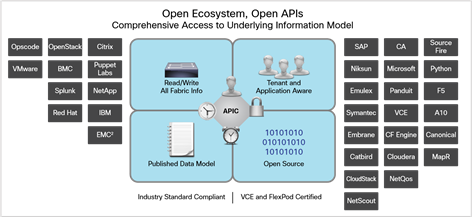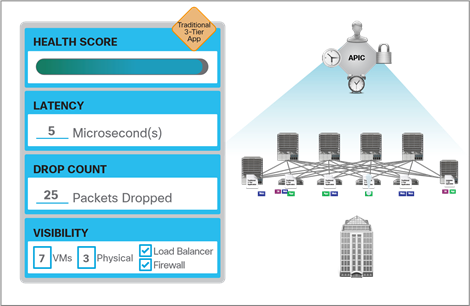Cisco Application Policy Infrastructure Controller (Cisco APIC) At-a-Glance
Available Languages
Bias-Free Language
The documentation set for this product strives to use bias-free language. For the purposes of this documentation set, bias-free is defined as language that does not imply discrimination based on age, disability, gender, racial identity, ethnic identity, sexual orientation, socioeconomic status, and intersectionality. Exceptions may be present in the documentation due to language that is hardcoded in the user interfaces of the product software, language used based on RFP documentation, or language that is used by a referenced third-party product. Learn more about how Cisco is using Inclusive Language.
Cisco Application Policy Infrastructure Controller
(Cisco APIC)
Overview
Cisco® Application Centric Infrastructure (ACI) is an innovative Data Center architecture that simplifies optimizes and accelerates the entire application lifecycle through a common policy management framework. Network, security, virtualization, and applications teams can now work in a common management architecture, enabling the disconnected management processes that have burdened most data centers to finally come together.
Cisco APIC serves as the single point of automation and fabric element management in both physical and virtual environments. As a result, operators can build fully automated and scalable multitenant networks.

Figure 1. Infrastructure Components of Cisco APIC
Cisco APIC attributes and features include the following (Figure 1):
● The ability to build and enforce application centric network policies
● An open framework through northbound and southbound APIs
● Integration of third-party Layer 4 through 7 services, virtualization, and management
● Intelligent telemetry and visibility for applications and tenants
● The ability to provide security for multitenant environments at scale
● A common policy platform for physical, virtual, and cloud networking
Application Centric Network Policies
Cisco APIC is the creation, repository, and enforcement point for Cisco ACI application policies, which you can set based on application-specific network requirements. Cisco APIC also provides policy authority and resolution mechanisms. Cisco ACI policies define connectivity, security, and networking requirements for agile and scalable application deployments.
Open Framework
The Cisco APIC framework enables broad ecosystem and industry interoperability with Cisco ACI. It enables interoperability between a Cisco ACI environment and management, orchestration, virtualization, and Layer 4 through 7 services from a broad range of vendors (Figure 2).
Cisco APIC provides centralized access to your Cisco ACI through an object-oriented RESTful API framework with XML and JSON binding. It also supports a modernized, user-extensible command-line interface (CLI) and GUI. APIs have full read and write access to the Cisco ACI, providing tenant- and application-aware programmability, automation, and system access.
Northbound APIs allow rapid integration with existing management and orchestration frameworks. They also allow integration with OpenStack interfaces to provide Cisco ACI policy consistency across physical, virtual, and cloud environments.
Southbound APIs let you extend Cisco ACI policies to existing virtualization and Layer 4 through 7 service and networking components. They will support computing and storage environments in the future. Cisco has submitted to the IETF the OpFlex protocol, which is intended to maintain control intelligence in the network infrastructure instead of centralizing it in a separate controller. The goal is to make the OpFlex draft, supported with partners IBM, Plexxi and Midokura, an open source version of the Cisco API data model to foster a broader ecosystem.
Figure 2. Cisco APIC Integration of Third-Party Services

Intelligent Telemetry and Visibility for Applications and Tenants
Cisco APIC provides centralized analytics and visibility of network health as it relates to applications and tenants. Cisco APIC is designed to provide application and tenant health at a system level by using real-time metrics, latency details, atomic counters, and detailed resource consumption statistics (Figure 3).
Figure 3. Cisco APIC Next-Generation Analytics Capabilities

Benefits of Cisco APIC
With Cisco APIC you get single-pane management of applications, security services, network services, and network configuration. This integration delivers the following benefits:
● Centralized, application-level visibility, with real-time application health monitoring across the physical and virtual environments
● Simplified operations across application, network, and security elements (with computing and storage elements to be added in the future)
● Common platform for managing physical, virtual, and cloud-based environments
● Investment protection of existing third-party environments that become interoperable with Cisco ACI
● Open APIs, open standards, and open source elements, which enable software flexibility for development and operations (DevOps) teams, and ecosystem partner integration
Cisco Services for ACI
Cisco offers a range of professional and technical services to support your deployment, including:
● Cisco Data Center Strategy & Analysis Service for ACI: Helps articulate the strategy, business case, and an architecture-led primary plan for ACI.
● Cisco Data Center Validation Service for ACI: Pilots the ACI solution and provides training.
● Cisco Data Center Assessment Service for ACI: Provides operations readiness, migration strategy, and a well-defined process for future migrations, including API evaluation to identify what current architecture elements should be integrated into the Cisco APIC.
● Cisco Data Center Design Service for ACI: Designs an ACI-based data center environment, including aspects of infrastructure, fabric POD planning and design, and application policy templates.
● Cisco Solution Support for ACI: Helps reduce disruptions while you transition to ACI by providing solution-level deliverables that include SMARTnet product support.
● Cisco Product Support is available globally 24/7 for Cisco software and hardware products and technologies associated with the Cisco Nexus 9000. Enhanced Ciscodelivered support options also include Cisco SMARTnet or Cisco Smart Net Total Care*.
* Cisco products only
For more details on Cisco Services for ACI, download our services At-A-Glance.
Why Cisco?
Cisco APIC and ACI are built on 29 years of innovation and product leadership along with broad market acceptance. They are transforming the next-generation data center and cloud deployments with streamlined application lifecycle management. They bring simplicity, flexibility, and scalability to tomorrow’s services transparently, which helps to lower your total cost of ownership.
Why Cisco Services?
With Cisco Services, you’ll know more, save more, and innovate more. You can rely on us because we’re the worldwide leader in IT that helps companies seize the opportunities of tomorrow. We have more than 29 years of experience, more than 50 million installed devices, and 6 million customer interactions each year. Delivered by Cisco and our Cisco Certified Partners, service engagements result in measurable business gains for our customers, who have achieved benefits such as 15-20% faster acceleration to revenue; 30% lower infrastructure costs; 50% faster disaster recovery; and 90% reduction in deployment time. For information about Cisco Services, visit www.cisco.com/go/services.
For More Information
Please visit http://www.cisco.com/go/aci.
For information about Cisco Services for ACI, contact as-aci-support@cisco.com.
C45-730001-01 05/14